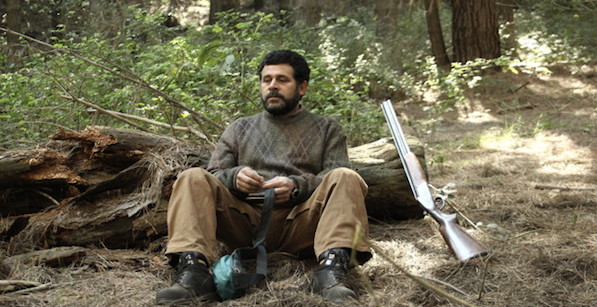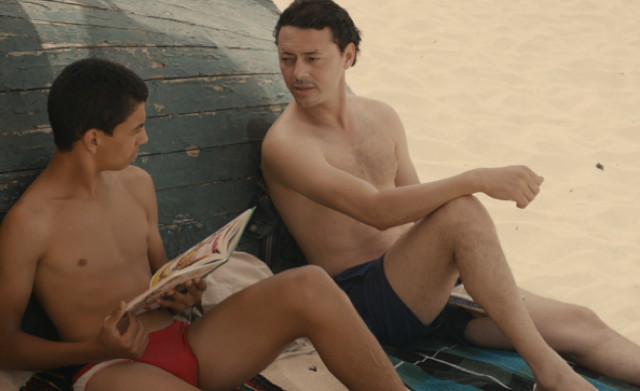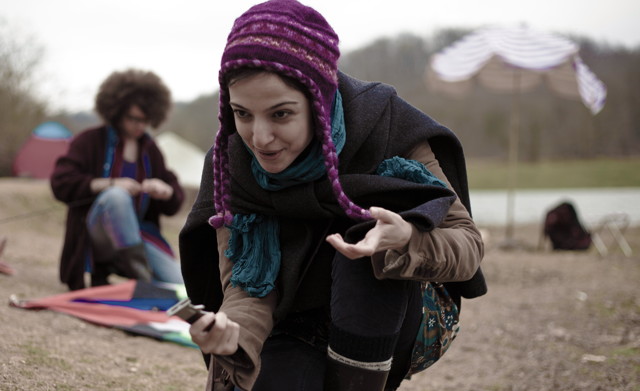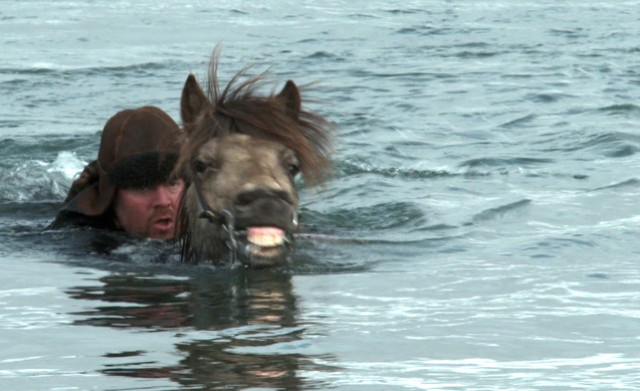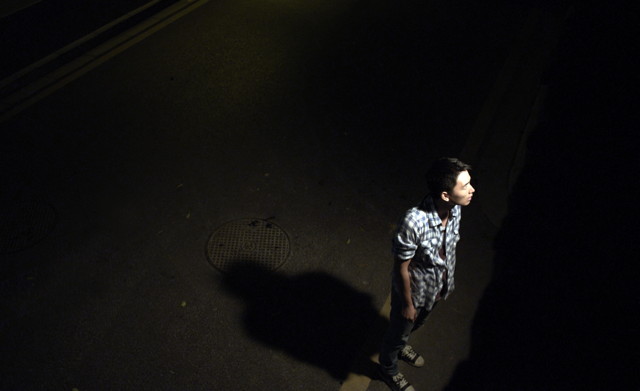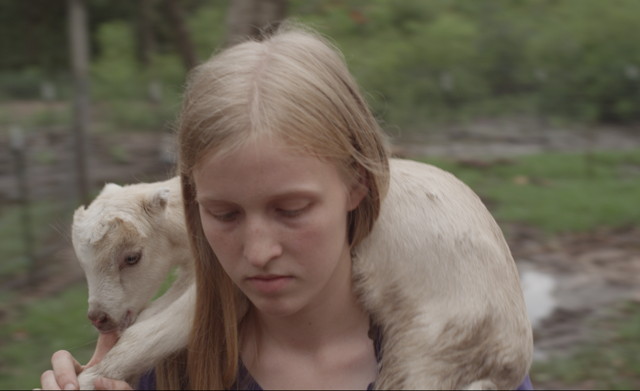It’s become something of a running joke amongst cinephiles how the Film Society of Lincoln Center can often times take a liberal approach to the nominal principles of its annual New Directors/New Films series. It’s true that traditionally the artists included are new directors, in the sense that they’re not veterans, while in most cases their newest—and in some instances their very first—works are on offer. Semantics are secondary, however, in light of the consistency and overall quality of the festival, which this year runs for eleven days and includes selections from at least as many countries. Truth be told, the absolute best films in this year’s line-up are festival triumphs of a very recent vintage—and some of 2013’s standout premieres at that. Amongst these, Ramon Zürcher’s The Strange Little Cat, Ben Rivers and Ben Russell’s A Spell to Ward Off the Darkness, and Albert Serra’s Story of My Death (the latter, to this writer’s mind, the best new film of the last year-plus—though from a filmmaker now upwards of five features deep), have been pretty well covered here in Keyframe. Others, meanwhile, have built-in hooks such as name recognition (20,000 Days on Earth), genre novelty (The Strange Color of Your Body’s Tears), or both (The Double) to attract curious eyes. For the purposes of this writing, then, I’ll focus on a handful of some of the lesser-known entities, films that may not have as presumed a chance at wider distribution or further festival berths as the aforementioned.
A number of this year’s ND/NF selections are legitimate debuts, and two amongst them (three if you include The Strange Little Cat) stand apart. Both Abdellah Taïa’s Salvation Army and Gilles Deroo and Marianne Pistone’s co-directed feature Mouton announce uncommonly confident, formally intrepid new voices in international cinema. Based on Taïa’s autobiographical novel, Salvation Army is a coming-of-age portrait centered on a young gay Moroccan man’s transition into adulthood that concerns itself less with sexuality than psychology, exploring a succession of emotionally defining moments and the accumulating affects of unrequited love on the life of the director’s surrogate protagonist, Abdellah (Saïd Mrini). Shot by the great Agnès Godard and utilizing but a modicum of stylistic gestures—with unadorned set-ups and precisely demarcated cuts instilling an acute sense of vulnerability in viewer and character alike—Salvation Army moves quickly but carefully between moments of adolescent discovery, a period of development when the briefest of encounters (here of both the intimate and interpersonal variety) can elicit the most lasting impressions. The way Taïa approaches his subject as if from an angle, granting us a glimpse of small but significant details, often focusing on specific expressions or extremities, is reminiscent at times of Robert Bresson—and the relation is just as often felt thematically, via Taïa’s interest in internal transformation and his willingness to allow emotional if not narrative closure.
Mouton also reflects the influence of Bresson, and a more thorough assimilation of the director’s spiritual concerns proves a key component to the film’s gnawing impact. The film opens as Aurelien (David Mérabet), condescendingly nicknamed Mouton (“Sheep”), is freed from his unfit mother and sent to live on his own in a seaside village where he finds work as a chef’s assistance. In tone, style, and subject matter, the first half of the film plays like a now-familiar post-Dardennes tale of proletariat struggle. And while a fine example of that particular mode of storytelling’s realist intrigue, Deroo and Pistone swiftly expand the coordinates of their narrative. Seemingly split into two acts, though soon fractured into even finer episodes, the film shifts gears emphatically as an unexpected act of violence inflicted upon Mouton effectively writes the character out of the narrative without killing him off. A succession of secondary characters are then elevated and excised as their lives advance in the absence Mouton. Title cards and voiceover become prominent components for the remainder of the film, and as the directors continue to interrogate the existential dimensions of a small town at once nurturing and negligent of its inhabitants, they’re able to locate an obtuse channel by which to access the ingrained contradictions of human nature. The handheld camerawork, accentuating the directors’ vérité-informed method of documentation, privileges the contours and physicality of the body, so much so that Mouton’s presence continues to press upon on the viewer’s mind and the narrative’s structure until it is splintered in seemingly unrelated formulations reminiscent only of life in its most volatile state.
The pivotal display of violence in Mouton, announced off-screen by an unseen narrator prior to the act itself, is echoed in a late moment in Fish & Cat, an ambitious, daunting, almost commendable show of technical prowess from Iranian director Shahram Mokri. Also disclosed by a heretofore unacknowledged voice before the moment of bloodshed transpires, this sequence eventually occurs out of frame, unlike in Mouton, and thus accounts for arguably the only instance of restraint in the entire film, bringing Fish & Cat to its long-overdue conclusion. Comprised of a single, continuous 134-minute shot (yes, a 134-minute shot, making it the second year in a row ND/NF has featured a single-shot film after J.P. Sniadecki’s and Libbie D. Cohn’s far superior People’s Park), the film outlines, in one painstaking stroke, an afternoon amidst the lakeside hinterlands where a threat of impending danger encircles a group of kite-flying college kids. Apparently based on a series of events which transpired around a remote restaurant that served human flesh to its unsuspecting customers, Fish & Cat fails to live up to its gruesome premise by consistently switching perspectives from its backwoods barbecuers (and most interesting characters) to the alternately forlorn, dimwitted and pretentious pack of students. The film’s early moments do build an air of morbid curiosity around the proceedings, but as sequences circle back on each other and are re-staged from various angles, whatever tension that Mokri is able to establish is deflated by meandering passages of dialogue and overwrought asides. Amongst the ND/NF program, its indulgence is matched only by the very different Of Horses and Men, an (I presume) allegorical conflation of human and animal instincts by Icelandic director Benedikt Erlingsson, which shoots for dark comedy but ends up closer to tragedy—and not intentionally.
The scope of these films stands in particularly stark contrast to some of other small-scale successes in the line-up. Alejandro Fernández Almendras’s To Kill a Man suggests a simple plot set-up, and it’s not giving anything away to say that the film eventually makes good on its title’s implications. There’s been an unfortunate trend in contemporary Latino cinema to depict the most ruthless and unforgiving aspects of the culture—surely a byproduct of the social turmoil within various countries, but one that was taken to numbing new ends recently with Amat Escalante’s Heli. Almendras’s film doesn’t refrain from such depictions of violence—in fact, it’s an almost procedural documentation of the steps one man will take to exact revenge on a neighbor who continues to torment his family—but there’s a far greater sense of conscience and consequence in its steely-eyed presentation. It may take Almendras until the final scene to reveal his greater objective, but it’s a moment which casts the preceding eighty minutes in a useful new light. Meanwhile, there’s Vivian Qu’s debut Trap Street, an otherwise dissimilar film but one which also upends expectations of violence in its closing passages. Initially an unassuming tale of a young mapping engineer (Lu Yulai) intrigued by a mysterious woman (He Wenchao) he encounters while surveying the streets of municipal China, the film slowly expands its genre considerations as Qu establishes a series of archetypes—the love-struck male, the conspiratorial organization he stumbles upon, and the femme fatale who potentially holds the secret to it all—only to forgo the plot contrivances which typically bring such characterizations into clearer motivational view. Trap Street ends on a pleasingly ambiguous note (with a wonderful final shot), setting in relief the film’s early, modest moments while bolstering intrigue on the viewer’s part of something potentially overlooked along the way.
Elsewhere in the program there are a couple of Romanian films which form a convenient pair, not simply because of their country of origin but in how they stand apart, both narratively and stylistically, from many of their contemporary counterparts. I wrote recently in a review of Călin Peter Netzer’s Child’s Pose of the new ways in which Romanian filmmakers are approaching narrative in the wake of their industry’s “new wave,” and both Tudor Cristian Jurgiu’s The Japanese Dog and Andrei Gruzsniczki’s Quod Erat Demonstrandum offer further evidence of this development, for better or worse. The former, a quiet, contemplative character piece concerning an aging husband (Victor Rebengiuc) who has lost his wife and home in a disastrous flood, is a beautiful, fragile look at familial relations and the difficult process of moving on in the face of tragedy. Jurgiu’s style, less formally rigid than typical Romanian fare but no less composed and patiently processed, owes a debt to Ozu—the director’s noted influence—as do his themes of generational discord and stoic resolve. The Japanese Dog (the title not as metaphorical as it initially seems) is a film that examines the weight of small details and transactions and considers how difficult it can be at times to take the smallest of steps away from routine and out of the past, and does so with considerable and seeming ease. Quod Erat Demonstrandum is, by contrast, less personal than it is political. Set in the late 1980s, Gruzsniczki’s film is another in a line of works from Romania to examine life under the Nicolae Ceaușescu regime, portraying the suffocating surveillance and suppression imposed upon a mathematician (Sorin Leoveanu) when the authorities learn of his decision to publish an academic paper in an American journal. This potentially involving premise, however, is never imbued with much palpable drama, as Gruzsniczki is left to rely on simplistic aesthetic tools—a piano-laced score, squeaky-clean black-and-white photography—to elevate tension but which has the adverse effect of flat-lining momentum. Not to put too fine a point on it, but there’s more to glean of the dictatorship in the margins of Corneliu Porumboiu’s latest film The Second Game—which essentially consists of a father and son sitting down to discuss a soccer match—than the entirety of this far-too-polite film.
Intentional or not, one of the themes of this year’s ND/NF is that of youth and the process of adolescent maturation, an evolution often dictated by social or political institutions. I spoke earlier of perhaps the two best in this field, Salvation Army and Mouton, but there are others still which approach such circumstances from differing angles. The brusquely titled Youth, from Israeli director Tom Shoval, is an obvious example, and that’s likely the intention. Following two teenage brothers (Eitan and David Cunio) as they concoct and execute a plan to kidnap the daughter of a rich local family in order to help provide for their father and mother who are set to lose their home, the film fascinates from a moral standpoint and Shoval proves well equipped at constructing drama. The narrative, however, is as blunt as its title: the brothers wear t-shirts emblazoned with the names of their favorite Hollywood action stars, their bedrooms lined with posters of the same, while the director’s themes of ingrained social expectations and the cyclical aspects of human nature are presented with little if any finesse. In light of such heavy-handedness, Roberto Minervini’s Stop the Pounding Heart plays even more elegantly than it already does on its own terms. The third in a loose trilogy of films the Italian-born director has made in Texas, Minervini’s latest takes an ever more diffuse approach to narrative, playing at times like a more earthbound Malick. Unraveling like a meditation on adolescence and spiritual resilience, Stop the Pounding Heart captures, in intuitive stylistic strokes, the flowering emotional life of a young girl (Sara Carlson) as she begins to question her place in a community that has different gender expectations than what she believes is appropriate for her own personal fulfillment. Reflecting his background in non-fiction filmmaking, Minervini focuses on what at first may seem like interstitial moments of youthful leisure, but in his respect for his characters’ inner lives and the histories of his chosen locale, he makes such fleeting passages feel like what they are: the foundation of a life lived as an individual.
One final film which doesn’t fall into any of the above categorizations, at least not entirely, is Jessica Oreck’s newest work The Vanquishing of the Witch Baba Yaga, which is as uniquely original and unforgettable as its title would imply. Part documentary, part first-person essay, part animation, Oreck’s ravishing meditation on nostalgia, shared histories, and the changing tides of culture in Eastern Europe after the fall of communism is less a narrative than a reflection, but one that nonetheless tells parallel tales of enlightenment. Alongside images of the post-war industrial and agricultural landscape—something like topographical portraits soundtracked in voiceover by stirring ruminations on nature and humanity (“Culture imagines an inherent advantage over the wild and builds high walls to keep it out,” etc.)—are sequences of intensely vivid, two-plane, hand-drawn illustrations which recount the Russian fairytale of Baba Yaga, a grotesque witch who seduces young children to do her bidding. These animated scenes, full of fantastically haunting imagery (magical combs, walking huts, talking animals), are seamlessly integrated into Oreck’s visual mosaic, effectively conveying her commitment to memories, traditions, the “retelling of stories retold,” and their place within our varied cultural lineage. In her singular assemblage of disparate aesthetic strands, and her radical disregard for conventional modes of storytelling, Oreck may most fully embody another, far more exciting interpretation of the label of a new director or a new film, that of fresh filmmaker creating an altogether new kind of art.

